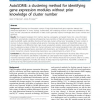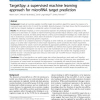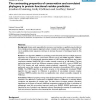1646 search results - page 326 / 330 » Automatic generation of two-party computations |
BMCBI
2010
13 years 7 months ago
2010
Background: Clustering the information content of large high-dimensional gene expression datasets has widespread application in "omics" biology. Unfortunately, the under...
BMCBI
2010
13 years 7 months ago
2010
Background: Virtually all currently available microRNA target site prediction algorithms require the presence of a (conserved) seed match to the 5' end of the microRNA. Recen...
BMCBI
2008
13 years 7 months ago
2008
Background: The expansion of automatic imaging technologies has created a need to be able to efficiently compare and review large sets of image data. To enable comparisons of imag...
BMCBI
2007
13 years 7 months ago
2007
Background: In recent years, mammalian protein-protein interaction network databases have been developed. The interactions in these databases are either extracted manually from lo...
BMCBI
2008
13 years 7 months ago
2008
Background: Amino acids responsible for structure, core function or specificity may be inferred from multiple protein sequence alignments where a limited set of residue types are ...



